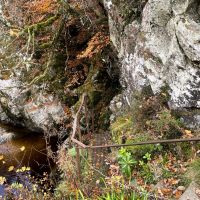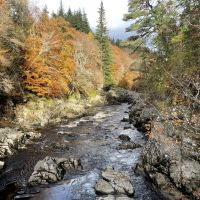24/10/24
River Findhorn
Somewhere I had read that the Findhorn River was one of the most underrated and beautiful rivers in Scotland. I don’t know how true that is. Certainly compared to famous rivers like the Tay, Spey or Tweed it seems little mentioned. Paul Murton is the source of most of our knowledge of Scotland’s geography and I’m pretty sure he hasn’t done a Grand Tour involving the Findhorn (yet).
Of course we wanted to see more of the river after hearing that, so we investigated possible options for a walk and stopover. The options seemed fairly limited, there were plenty of walks but not so many obvious places to park up a large vehicle. In the end we opted to go to Logie Steading where we could start the walk to the romantic sounding Randolph’s Leap.
Logie Steading was an easy drive and offered more than just an opportunity to go for a walk. We investigated the buildings, laid out around a central courtyard in a fairly traditional steading pattern. There are shops, including a farm shop, garden centre and clothes. There’s a very popular cafe. Also it is a location for the Rivers Trust where there is a small information centre.

Parked up at Logie Steading in the morning. It got a lot busier than this.
The walk to Randolph’s Leap is one of several that are signposted from the steading. We walked through the playpark and a small newly planted orchard towards the river. The path is easy to follow and easy going until it meets a road. Then, after crossing a bridge and following the road uphill, the landscape becomes rockier and the gorge starts to develop. Everything starts to feel more dramatic with the river creating rapids and cascades between the rocks which are scoured into smooth hollows. Ladders and chains provide precarious access to small beaches and platforms for fishermen. Two flood stones mark the height of flood waters from the Muckle Spate (muckle means ‘big’ or ‘great’ in Scots) of 1829 when it is said that flood waters rose 15 meters above their usual levels. The result of huge amounts of rain being squeezed through the narrow stretches of the river and many others in the area.
Randolph’s Leap itself is at a point where the rocks of the gorge come close together. Earl Randolph didn’t leap across himself, but rather it is said that he was trying to put down a rebellion and chased the several members of the Cumming family who made the leap. Would it be possible? I think you’d get a bit wet in the process.
On our return we went into the cafe, but all tables were full and there were already people waiting like hawks to take advantage of any hint that a table was being vacated. We decided that we wouldn’t compete. Instead we popped over to the farm shop instead and spent a small fortune on venison and locally reared beef. Our lunch ended up being a smorgasbord of treats from the shop.
Overnight at Nairn Harbour
As it was only lunch time and we couldn’t stay overnight at the Steading we moved on to Nairn harbour where we found motorhome OSBs (Overnight Sleeping Bays). These parking spots are provided by the Highland Council and intended to allow motorhomes to stop overnight in car parks without parking too close together. Here, for example, there were four overnight bays but several more motorhome parking daytime bays. I can see the logic although, having been to some popular continental motorhome parking areas, we’re quite used to being cheek by jowl with others.

Overnight Sleeping Bay (OSB) at Nairn Harbour
As I went to pay for our overnight parking (a very reasonable £10) someone jumped out of one of the other vans to tell us not to pay. “It’s only a suggestion” she said, and seemed very confused by my determination to pay anyway. If people don’t pay for these parking spots we’ll just lose them. The same van then proceeded to empty their grey waste and let it spill out across the tarmac before they left. It’s the sort of behaviour that gives motorhomes a bad name. We had a good chunter about it with one of our other neighbouring vans.
The parking area was busy overnight, with several more motorhomes turning up, some moving on when they saw the OSBs occupied and some deciding to risk staying over.
Culbin Forest
Once we’d settled into our parking we decided to get the bikes out and head to Culbin Forest. We wondered if we would be able to make it as far as the Findhorn but it was not to be.
We had to cross the footbridge over the River Nairn and cycle through the holiday park which was still pretty busy with half term holiday makers. There were lots of narrow tracks through the forest that made for fun mountain biking even though it was pretty flat overall. One of those tracks took us out to the wetlands between the forest and sea and we decided to stay on the boggy ground for a bit where we could see the big skies and watch the many flocks of geese take off and land each time they were startled.

Boggy cycling
Our foray into the wetlands ended when the going became too boggy for the bikes to handle. We’d been lulled into thinking it was easy going and hadn’t quite realised how wet it was under our wheels. By the time we realised we were in trouble there was no easy access back into the forest. We should have just turned around but instead we spent a bit of time pushing the bikes over black mud and sinking tufts of grass. Our feet got soaking wet and our spirits a little deflated. We consoled ourselves with planning a warm dinner of pie and mash so that once we were back onto recognisable forest tracks we’d cheered up.






